I've made a start on my sampler. Initially, I was going to follow the sampler directions in Learning To Weave, but then changed my mind. I wanted to weave a sampler, but after learning how to adapt weaving drafts for a direct tie-up table loom, I was more interested in experimenting with this and putting the loom through its paces. (Or maybe putting me through my paces.)
Finding that blog post about lashing on the warp reminded me about the two-stick header.
Then I started pulling in the weft a little more before beating and it was better after that.
So far, I have five, three-inch samples to show you. Both warp and weft are 8/2s cotton. Sett is 20 epi. Threading is straight draw (1, 2, 3, 4, repeat).
Sample 1

|
| Plain weave |
1-32-4repeat
1-22-33-41-4repeat
Sample 3

|
|
Vertical herringbone from Marguerite Porter Davison's A Handweaver's Pattern Book. |
3-41-41-22-31-42-42-31-2repeat
Sample 4
41-22-33-4repeat
There are a couple of things to note on this sample. One is the weft bump in the center of the sample.
 |
| Freyed weft thread. |
Since this was just a sample, I didn't worry about it.
This is common with twills, and the solution is usually to change the direction that the shuttle is thrown. For this pattern, that simply shifted the warp float from one selvedge to the other. The answer would be a floating selvedge.
A floating selvedge is a warp thread on the outer edge of the warp, which is not threaded through a heddle. That means it isn't subject to the lift pattern and potential warp floats. Discovering this is an excellent reason to always sample!
Sample 5
 |
| Ribs 3 & 1 from Marguerite Porter Davison's A Handweaver's Pattern Book. |
12-3-412-3-4repeat
Observations so far:
- I need practice but the sampler is turning out better than I thought!
- I especially need to develop consistent beating. Part of what I need to get used to is that there are two positions for the beater bar. I'm not really sure when to change, but I suspect this affects my weaving.
- The loom is quiet
- Nice clean shed
- No tension problems! (notable after using the no tension to wind on the warp method)
- I need a taller stool (or a shorter table)





No comments:
Post a Comment